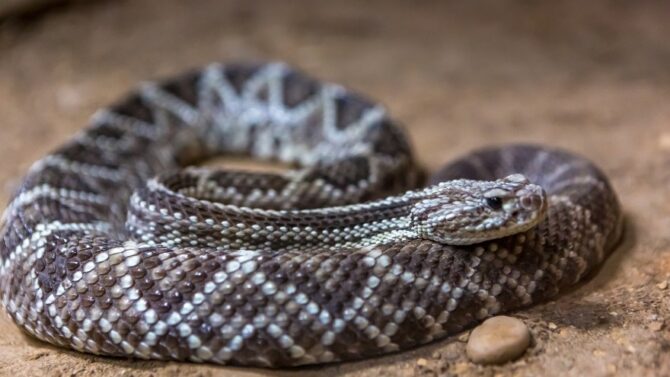South Carolina is a state found in the Southeastern region of the United States. It is surrounded by North Carolina, the Atlantic Ocean, and Georgia.
Like many other states, it comprises various habitats that make good homes for many animals. Our creature of interest is the owl.
Four species of owls in South Carolina remain all year. These are the barred owl, barn owl, great horned owl, and eastern screech owl. Added to these are three more species that are known to migrate to South Carolina.
Here’s a walkthrough of the owl species that live in South Carolina, with their peculiarities and how to identify them.
Species of Owls in South Carolina
1. Eastern Screech Owl

- Length: 6 to 10 inches
- Weight: 4 to 9 pounds
- Wingspan: 19 to 24 inches
- Scientific name: Megascops asio
The eastern screech owl is well known in the eastern parts of North America, from Mexico to Canada and some parts of the United States.
It lives all year in South Carolina, but good luck trying to find it. Not only is it small, but it also has grey feathers that help with camouflage. Your best bet would be to listen out for its distinct sound, a bit like a horse.
Ways to easily recognize the eastern screech owl is by its large head, ear tufts, yellow beak, and equally yellow eyes. It has feathers going down to the legs along with large feet.
This bird is often compared to its close relative, the western screech, and they both have a lot in common. Their main differences are in their sounds and size.
The eastern screech feeds on insects, crayfish, spiders, and snails. It is an opportunistic hunter that can take up prey larger than it.
2. Barn Owl
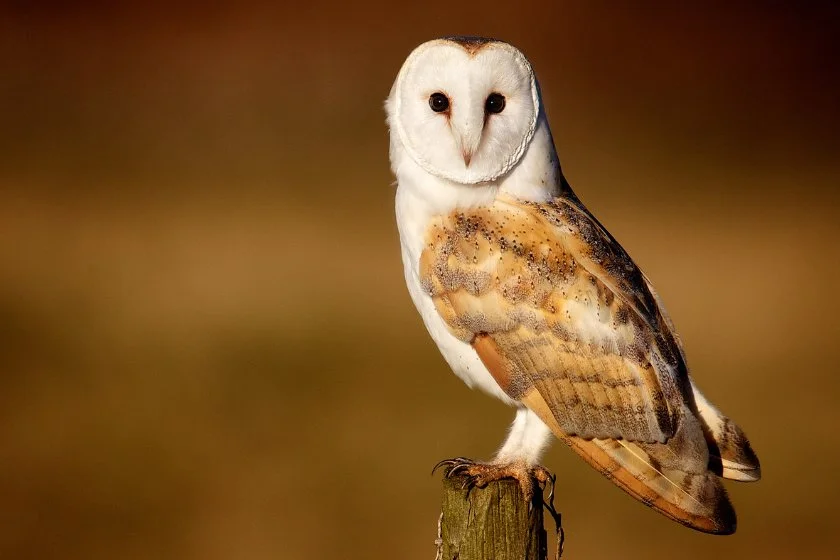
- Length: 13 to 16 inches
- Weight: 14 to 25 pounds
- Wingspan: 40 to 50 inches
- Scientific name: Tyto Alba
The barn owl is the most widespread in the world, and you can find it in every continent except Antarctica and the Polar regions.
It is also arguably the most feared. Its mysterious looks, pale appearance, and dark eyes don’t help its reputation. That said, the barn owl is harmless.
It got its name from living in barns and abandoned buildings. You can find it all year in South Carolina.
Some popular spots in the state include the Congaree National Park, the Oak Ridge Greenway, and the Francis Marion National Forest.
Some people fancy having barn owls in their environment, especially farmers in dire need of some natural rodent control.
If you fall under this category, you can make your environment more endearing to these creatures by creating a nest box and providing a food source.
Sometimes, you might unexpectedly find one living close to you. Do not fret. The creature can be advantageous especially because it feeds a lot on rodents.
It is nocturnal but in places like Great Britain, it hunts by day.
3. Barred Owl
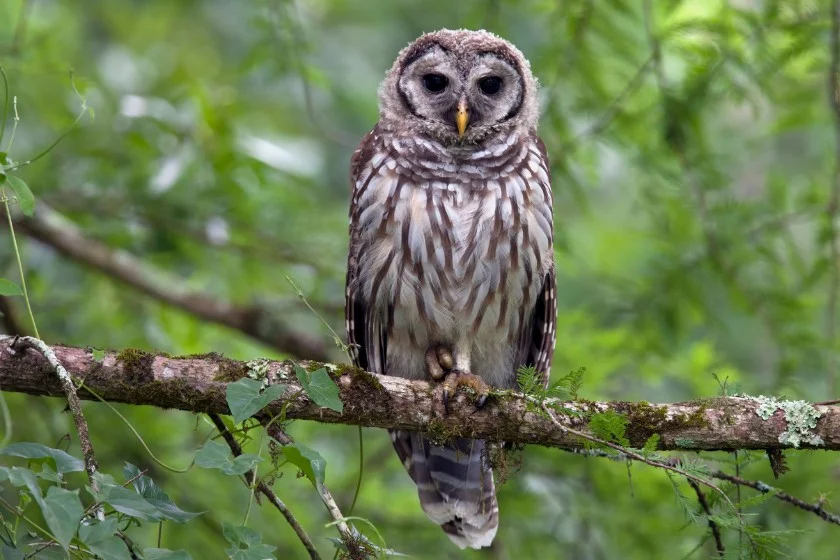
- Length: 17 to 20 inches
- Weight: 16 to 37 pounds
- Wingspan: 39 to 43 inches
- Scientific name: Strix varia
The barred owl is a large species often found in North America. It is also a year-round creature in South Carolina.
This bird goes by other names like hoot owl, striped owl, or a more formal name which is the northern barred owl.
The barred owl stays in the lower parts of South Carolina, staying close to the coasts.
Its preferred habitats are forests, so you could visit places like the Clemson Experimental Forest, the Sumter National Forest, and the Francis Marion National Forest.
Popular colors of the barred owl are brown or greyish brown, with white bars all over the plumage.
A carnivore like many other owls, the barred owl hunts and eats small mammals and other animals like birds, reptiles, and amphibians.
4. Great-horned Owl
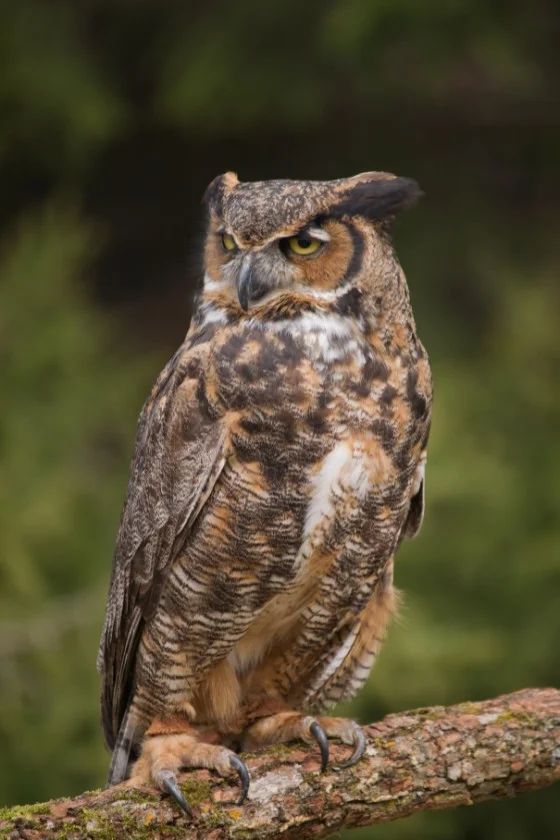
- Length: 18 to 25 inches
- Weight: 32 to 88 pounds
- Wingspan: 40 to 57 inches
- Scientific name: Bubo virginianus
The great horned owl is a native of the Americas and the most distributed true owl in its range. It goes by other names like tiger owl and hoot owl.
It is also considered the earliest nesting owl in North America. This is the species you see in storybooks.1
A large creature, it can be easily seen if you step out at night. It stays throughout the year in South Carolina and can adapt to a variety of habitats.
One popular spot to locate this bird is the Santee National Wildlife Refuge, where many birds can be found.
An expert in camouflage, the great horned owl seems designed for this. It is colored a mottled brown on the upper parts and lighter on the underparts.
This combination makes it harder for prey to sight it. It also flies silently, catching its game unawares.
The great horned owl feeds on rodents, insects, and many other small animals.
5. Northern Saw-whet Owl
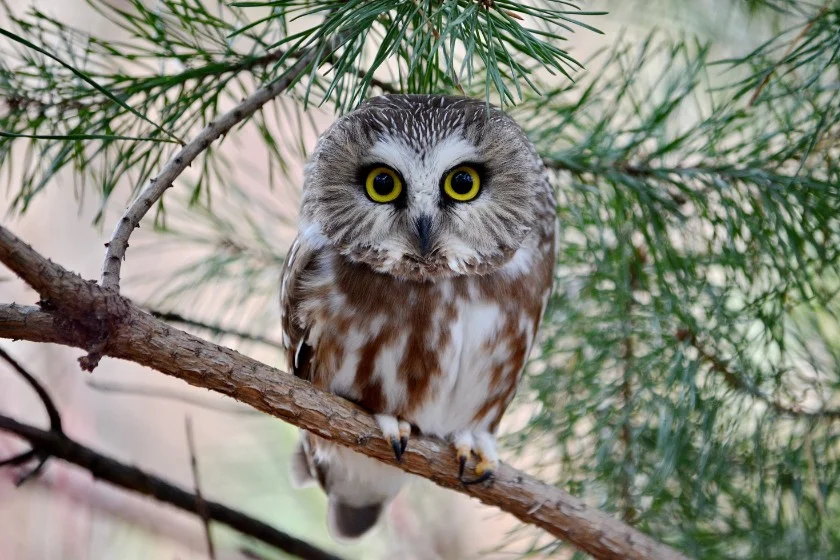
- Length: 7 to 9 inches
- Weight: 2 to 5 pounds
- Wingspan: 17 to 22 inches
- Scientific name: Aegolius acadius
The northern saw-whet owl has a large head and yellow eyes but is a tiny bird. It is considered one of the tiniest in North America, about the size of a robin.
It is migratory and can only be found in South Carolina during the winter. It often stays in forests.
The name “saw-whet” comes from its sound, which people describe as being like a saw being sharpened on a whetstone.
The best places to visit when you need to see a saw-whet owl in South Carolina are the Francis Marion National Forest and the Clemson Experimental Forest.
It can also get close to human dwelling, and you can make it more possible by getting together a nesting box and a water source.
The saw-whet feeds on smaller animals that it can easily hunt down. It often waits on a high branch and swoops down to grab the intended prey. Examples of animals it feeds on are shrews, squirrels, moles, bats, and mice.
6. Short-eared Owl
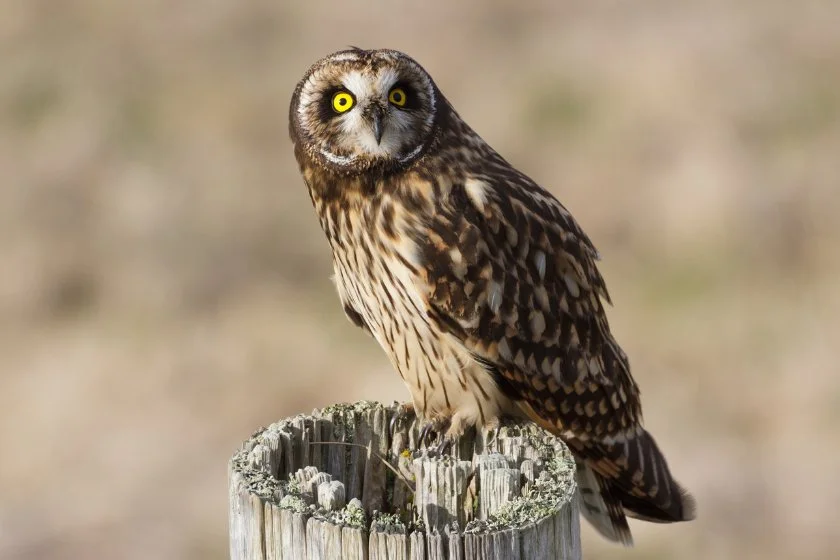
- Length: 14 to 17 inches
- Weight: 7 to 17 pounds
- Wingspan: 34 to 41 inches
- Scientific name: Asio flammeus
The short-eared owl falls under the genus Asio alongside the long-eared and a host of others like the Abyssinian and the Madagascar owls.
All members of the Asio genus are called eared owls because of the feather tuft on the head resembling ears. The short-eared owl is named after its tiny tufts.
The bird is widespread, occurring in every continent except Antarctica and Australia.
It doesn’t remain in South Carolina all year round, but can often be found during the winter. Its preferred habitats are prairies, grasslands, and open spaces. It feeds mainly on rodents and is diurnal.
Places you can find a short-eared owl include the Savannah National Wildlife Refuge, the Francis Marion National Forest, and the J. Strom Thurmond Lake.
You can draw it in your backyard using similar methods as some other birds already mentioned. Get a nest box or a water source.
7. Long-eared Owl

- Length: 14 to 16 inches
- Weight: 8 to 15 pounds
- Wingspan: 36 to 40 inches
- Scientific name: Asio otus
The long-eared owl is a relative of the short-eared counterpart, with long ear tufts. This species is rare in South Carolina, but you can find it during the winter.
It is also called the northern long-eared owl, the lesser owl, and the cat owl. It shows a preference for open habitats and rather than build its nest, it inhabits those of other animals.
In South Carolina, you can find the long-eared owl in the Congaree National Park and close to Clemson University.
It loves trees, so it is more likely to come close to your environment if you have trees. Having a good food source wouldn’t hurt.
Besides having a long feather tuft, the long-eared owl is known to be slim and with long wings. It also has light skin, and the females tend to be bigger than the males.
This creature is considered a specialized predator as it tends to focus on rodents as prey. However, it can adapt to other prey like birds and insects.
Conclusion
South Carolina contains much wildlife, including a couple of owl species. These owls in South Carolina can either be found all around or during the winter season.
Each of them has its peculiar looks, habitat, and even vocals. Contrary to assumptions, not all owls hoot.
Next up…
- 10 Owls In North Carolina (Species Identification, Pictures)
- 10 Most Dangerous Animals In South Carolina (Watch Out)
- Wildlife In America – Native Animals In The United States
References & Notes
Facts Sources:
- Great Horned Owl. Audubon Field Guide.




